Keep the Power On and Stay Off the Grid with These Top Solar Panels for RVs
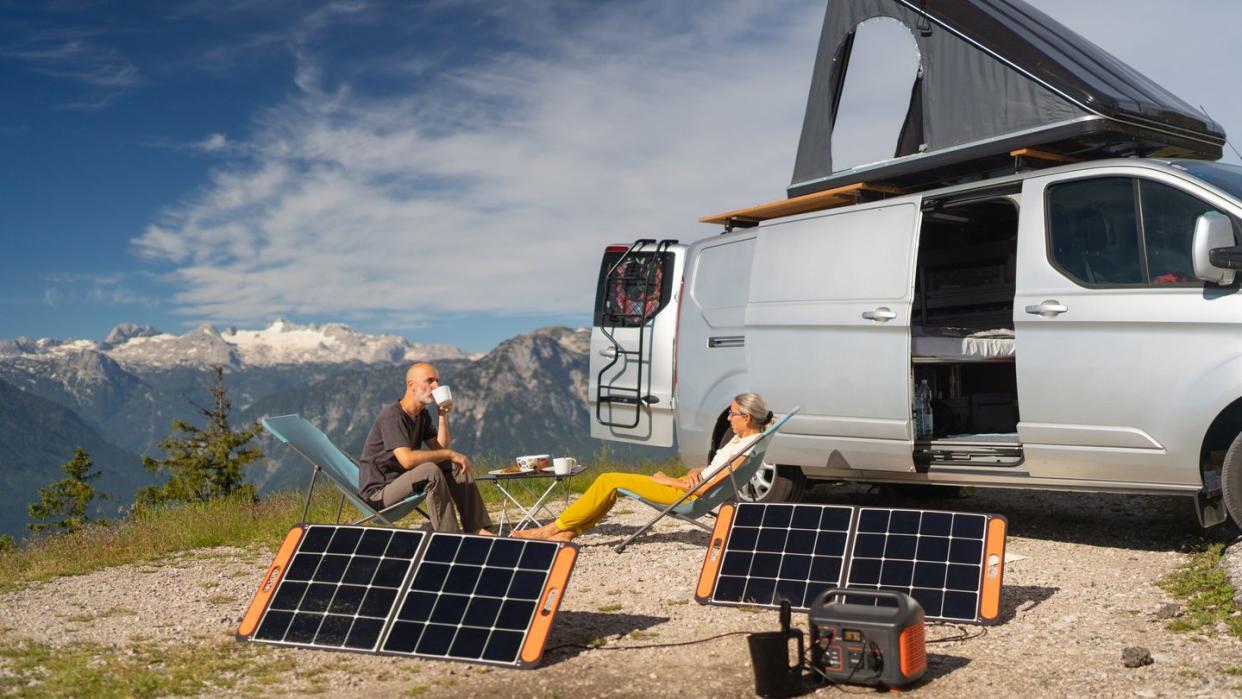
"Hearst Magazines and Yahoo may earn commission or revenue on some items through these links."
There was a time when portable solar panels were more of a novelty than a practical camping tool, but with the rise of green tech and more demand than ever for emergency and off-grid power, they have become a highly effective way to charge a portable generator. Both have become modern essentials for long road trips in an RV and camping.
But solar panels can be finicky. They aren’t always designed to endure the rigors of the great outdoors. And frankly, some of them simply don’t work as well as they should. Unlike the large, heavy solar panels you might install on the roof of your home, RVers need panels that are either compact enough to fit on a vehicle, or portable enough to stow inside.
A great RV solar panel, whether foldable or fixed on the roof, needs to deliver effective energy production and feature a rugged design that can handle dust and rain. If you’re packing up and hitting the road this summer, we recommend pairing your solar generator with a set of the best RV solar panels.
The Best RV Solar Panels
Best Overall: Renogy 200W 12-Volt Solar RV Kit
Best Value: Eco-Worthy 100W Solar Panel
Best Mounted: Go Power! Overlander 190W Solar Kit for RVs
Best Lightweight: Renogy Flexible Monocrystalline RV Solar Panel
Best Premium Portable: Bluetti PV350 Solar Panel
The Expert: I’ve used portable solar panels about as extensively as is humanly possible. I relied on them for five years to power my remote work setup through some 40,000 miles of road-tripping all across North America. That work included reviewing solar panels, portable power stations and other relevant gear for leading publications like Popular Mechanics, Popular Science, The Daily Beast and Thrillist, among others.
What to Consider in a Set of RV Solar Panels
Materials
Solar panel materials are most frequently made from using silicon crystal, which captures solar energy. These panels come in one of two types: Monocrystalline silicon panels are made with a single panel of crystal, while polycrystalline panels are constructed from multiple crystal fragments. Monocrystalline panels are more efficient because it’s easier for electricity to move through an unbroken crystal. Given that, all of our recommendations are monocrystalline panels.
They can also largely be divided by whether they have a rigid or flexible structure. Rigid panels are a great option for flat-topped RVs, but if your rig has a curved or uneven rooftop, you may want the surface-hugging malleability of a flexible option. Both types are available with similar levels of weather resistance, though rigid panels often take a slight edge when it comes to efficiency of energy production.
Panel Placement–Portable or Mounted?
Before you buy your panels, consider where and how you plan to set them up. You want them to face the sun as directly as possible, for as long as possible. How you position your panels will vary quite a bit, depending on whether you use mounted or portable panels.
With an RV, you have the option to mount your panels directly on your vehicle. A rigid, mountable panel will be more durable than a portable set, water- and windproof to brave the elements, but they require some elbow grease to install. You may also find yourself unable to park in an ideal spot to catch the sun, limiting your capture capacity for the day.
They tend to sit face-up on the roof and aren’t adjustable, so you’ll have a narrow window for maximum efficiency. On the other hand, your rooftop panels will capture energy while you drive, so they’ll draw power for a larger portion of the day.
Portable solar panels are more flexible, literally and figuratively. They fold up for compact storage, and are designed to be easy to set up and tear down. They often have integrated kickstands and handles to help you optimize your placement, no matter where you’ve posted up for the night.
That said, you need to be careful to put them away when the weather turns gray: They are scratch-resistant and can handle a light shower, but they’re typically not meant to stay outside around the clock. And unlike rooftop panels, which are bolted in place, you may not feel safe leaving your portable, easily stolen panels out while away from your campsite, meaning you can only generate power while you’re there.
Wattage and Efficiency
A solar panel's wattage specification indicates the amount of power it can produce in one hour. Most RVs and campers can get enough juice to power their appliances and a few electronic devices for a full day from a 100- to 500-watt solar panel setup. A slim 100-watt panel will provide enough juice to power a small fridge, a toaster and a coffee maker.
We imagine, though, that most RVers have more gear than that: If you have an electric stove or a large fridge, we recommend using panels that can bring in at least 400 watts. If you have electronics that need regular charging, like a smartphone or laptop, you’ll need to collect extra power for that as well.
Whatever your daily power consumption is, aim for having a system that will produce at least two-to-three times that if you expect to use electricity around the clock for multiple days on end. Every person’s exact power needs will vary. If you aren’t sure what you need, we recommend starting small and upgrading when and if you need to. You can always buy multiple panels, rather than upgrading to a more efficient model.
One thing to keep in mind: Wattage and other specs provided by manufacturers, including those cited in this guide, describe how the panel will work in optimal conditions—a bright, sunny day without a cloud in the sky. More often than not, you will pull less energy than advertised. To get a better sense of what you can actually expect on an average day, check the efficiency rate, which estimates the panel’s capacity to convert sunlight into usable electricity. The best solar panels operate at 23 percent or higher.
Weight
If you go with foldable panels, make sure you can pick them up and pack them up comfortably, because you will be moving them around a lot. Generally speaking, the higher the wattage rating, the heavier the panels. So, while it might seem convenient to rely on a single 400-watt unit, you may be better off setting up two or more panels than setting up and adjusting something that weighs as much as 40 pounds.
How We Selected The Best RV Solar Panels
We picked the best RV solar panels based on years of experience testing and recommending solar gear, including generators and panels. We also researched panel specs and performance, including data and recommendations from specialty outlets like Treehugger and SolarReviews.
In making our selections, we considered many scenarios for RV owners and power setups to present a range of options that work for as many people as possible. Having spent years and many miles on the road working remotely, I've learned firsthand about the benefits and pitfalls of different solar setups. Lastly, we checked consumer reviews for all of these picks to make sure we didn’t accidentally select a panel that looked perfect on paper, but was actually a lemon. These are the best RV solar panels to keep you powered up on the road.
200W 12-Volt Solar RV Kit
This kit has everything you need for easy installation on your RV or camper. It’s made specifically for first-time solar panel users, with a straightforward, user-friendly design. For smaller van conversions, you’re probably better off with a portable power station, but this is exactly the kit you need for mid-sized vehicles like Sprinter vans or camper trailers and medium-sized RVs where you want the convenience of power going directly to your rig’s battery.
The two 100-watt solar panels are rigid but relatively lightweight at 18 pounds–and the kit comes with everything you need to mount them. The included charge controller has LED indicators that allow you to monitor charging, which will help you avoid overcharging or, worse, overloading your system. They also alert you to input changes due to weather conditions like rain, clouds, or nightfall.
The aluminum frame panels are UV- and corrosion-resistant to withstand high winds, rain, snow, and blazing heat, so they’ll take just about whatever the elements throw at you. For anyone looking to install their first RV solar panels on their own, this kit is an excellent pick.
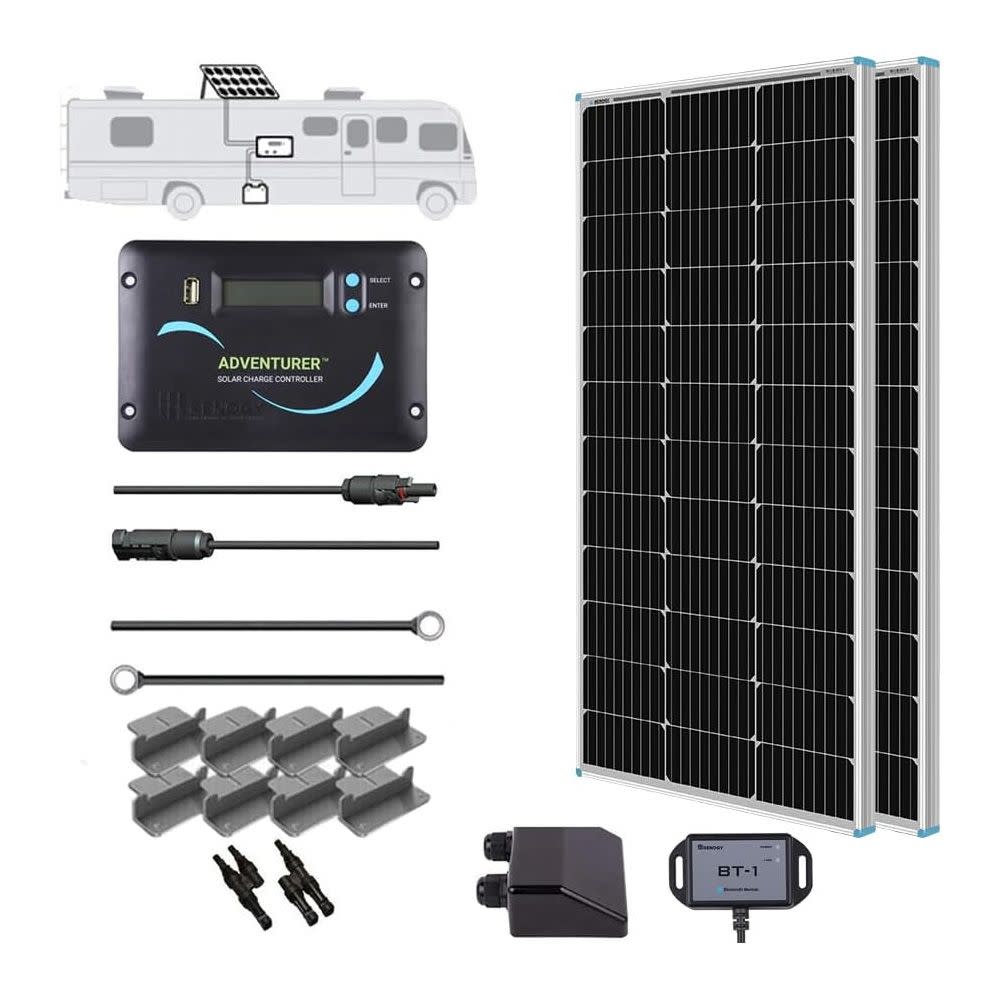
200W 12-Volt Solar RV Kit
amazon.com
$269.99
100W 12V Solar Panel
There’s nothing fancy about these panels from Eco-Worthy, but that’s kind of the point. They’re exactly what you need if you’re looking to set up solar panels on your RV for as little as possible. They’re the perfect size for mounting via the pre-drilled mounting holes, and you should be able to fit three to four of them on most RV rooftops. They come with integrated 35-inch connectors that run into a waterproof junction box, and the whole panel is waterproofed with sealed and tempered glass.
They’re surprisingly durable for such low-cost panels, too. Once you’ve got them on your RV roof, however, they should last for years.
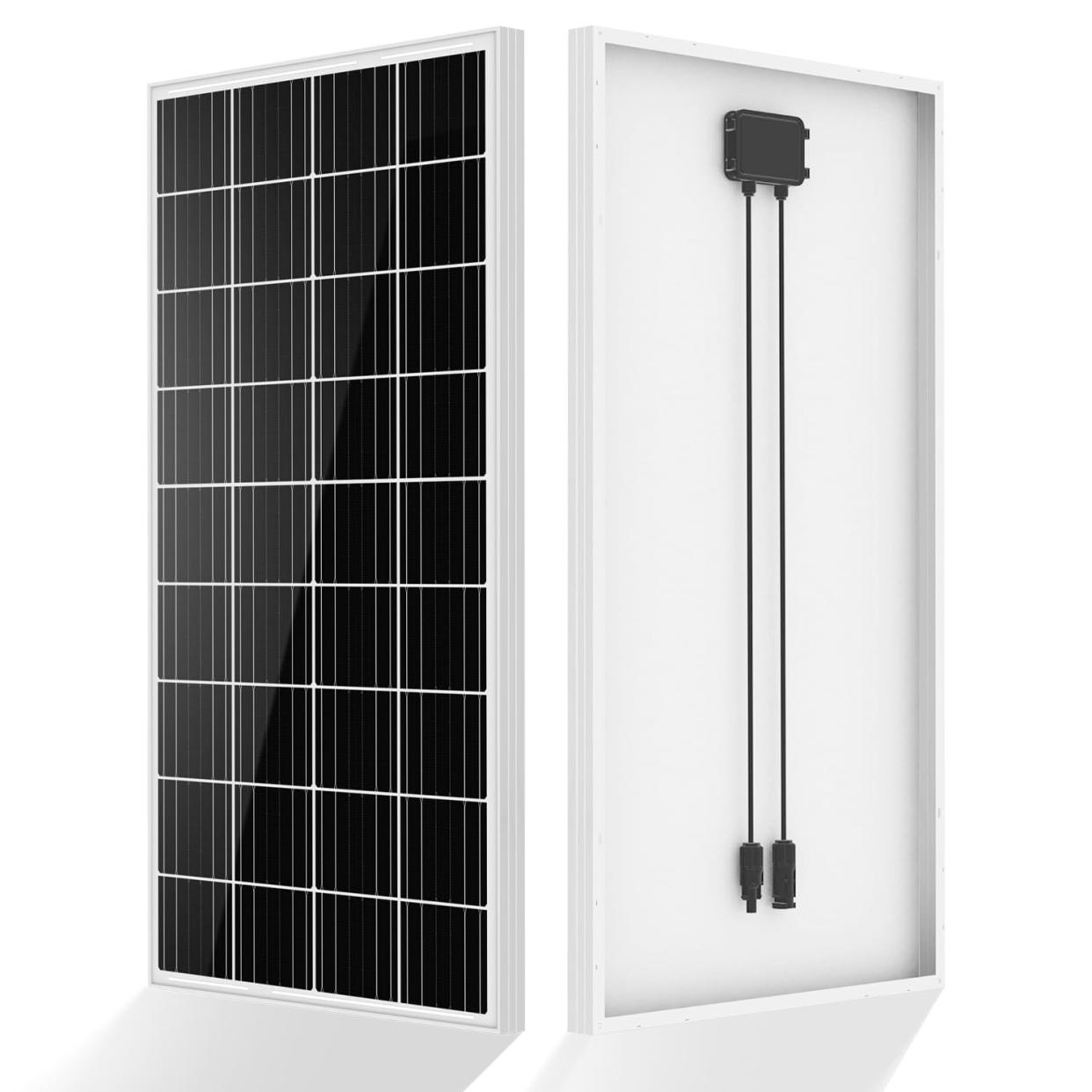
100W 12V Solar Panel
amazon.com
$59.99
Overlander 190W Solar Kit for RVs
This extremely large 12-volt panel draws up to 190 Watts of power to keep any battery charged on long trips, camping, or on the road. It’s a bit heavy–26 pounds–but its anodized aluminum frame and durable tempered glass panels hold up well against rough weather. Customers report easy installation and that the controller maintains power in their RVs even in less-than-ideal conditions like partly cloudy skies and rain.
If you need more power, the company sells an expansion kit that doubles the output. It’s designed for seamless connectivity between your existing solar power system and the panels you want to add for more power. If you need a lot of juice, this is probably the best mounted panel for the job.
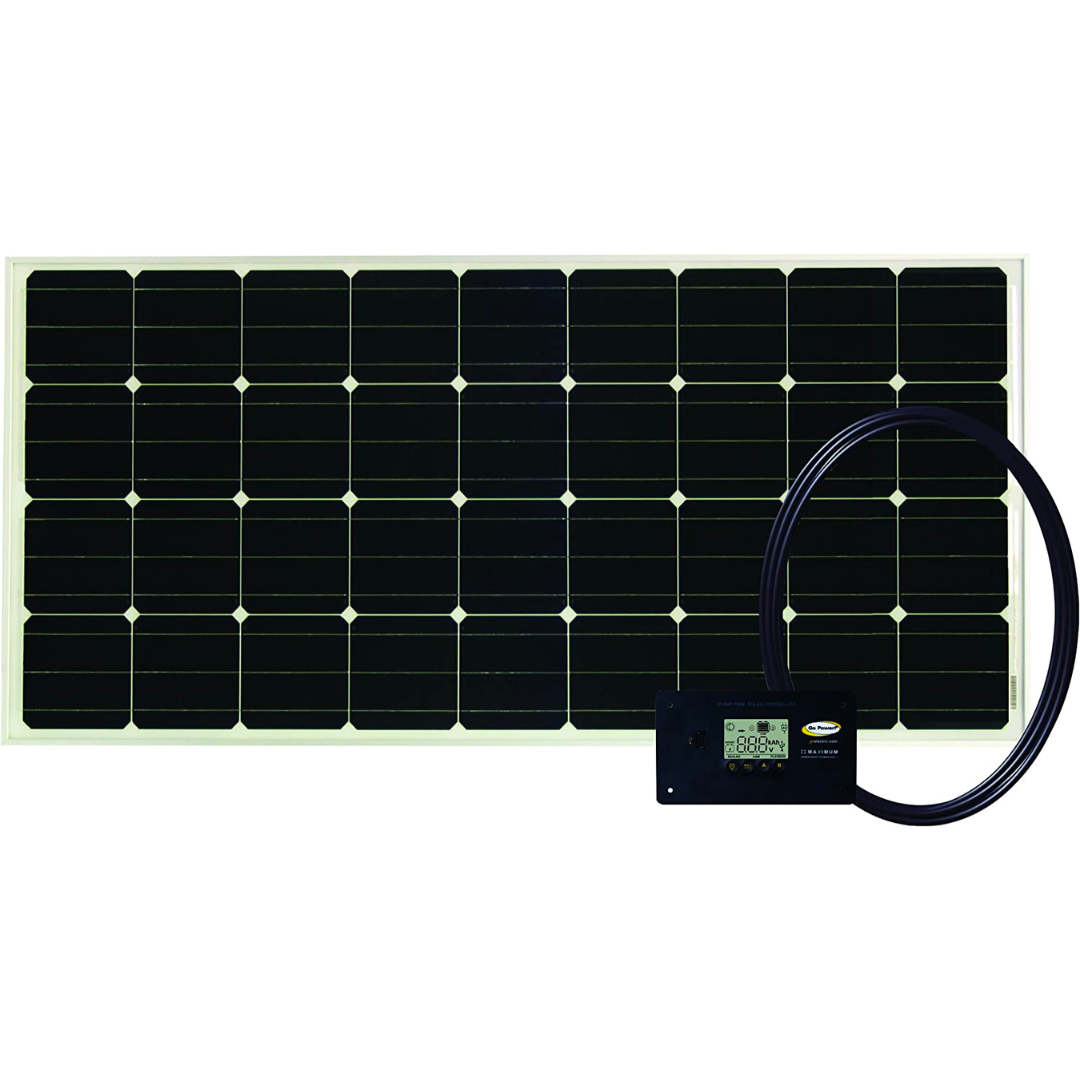
Overlander 190W Solar Kit for RVs
amazon.com
$578.71
100W 12V Flexible RV Solar Panel
This bendable RV solar panel is great for uneven surfaces like Airstreams and vans, or propped up facing the sun at your campsite. It weighs just 4 pounds and can withstand high winds, rain, and snow.
The mounting uses silicone adhesive for permanent installation without any drilling. It can flex up to 248 degrees without any micro-cracks forming, which is handy for hitting the right angle after mid-day.
Customers like the slim profile of these panels and say the output is great for such lightweight panels. These are best suited for small camper set-ups or as expansions to larger RV solar energy systems, as just one or two of these aren’t enough for a large RV with a lot of appliances.
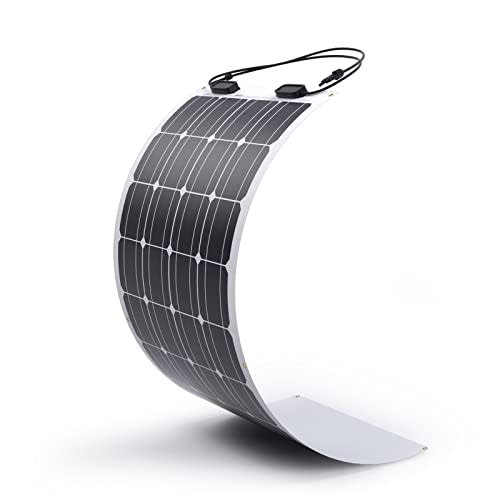
100W 12V Flexible RV Solar Panel
amazon.com
$143.99
PV350 Solar Panel
Bluetti makes some of the best solar gear in the industry, and the PV350 solar panel is an upscale buy that’s worth the investment. It absorbs up to 350 watts per hour, which is huge for a folding panel. At the same time, it’s remarkably compact, folding down to a compact 35.6- by 24.1-inches for easy storage.
There’s a downside, of course–it weighs 30 pounds–which may make it tough to set up. You can’t beat that size-to-wattage ratio, though.
It’s also designed for efficiency. The cells are wired in parallel, rather than in a daisy-chained configuration like you find in most cheaper panels. This allows it to continue collecting power when mostly shaded. (Many panels will stop operating if they aren’t getting very good coverage.)
The PV350 is also well-built. Nick took one on a trip through the deserts of Utah and Nevada, where it saw no shortage of hard treatment from dust, wind and my own rough handling, but emerged without any major damage. That said, it isn’t fully waterproof: You can leave it out through a light drizzle, but avoid charging on rainy days.
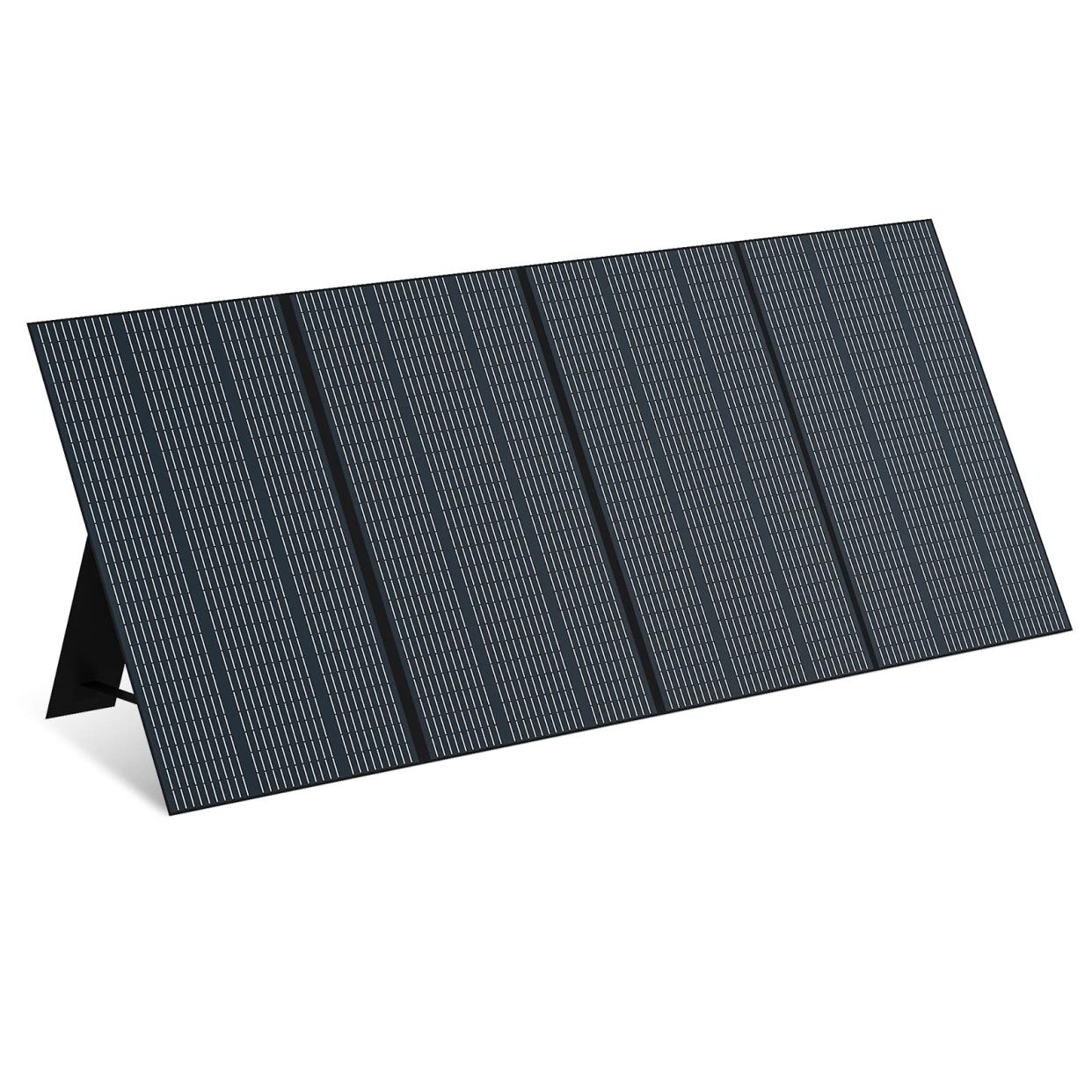
PV350 Solar Panel
amazon.com
$849.00
Nomad 100
Goal Zero is known for making tough, outdoor-friendly solar gear for camping. Case in point, the Nomad 100 is perfect for pretty much any camping scenario, whether you’re charging up your RV or a portable power station. Weatherproof and built like a rock, it’s designed with tie-down loops around the frame. These are great for both staking it into the ground or affixing it to your RV rooftop to keep it in place when the wind kicks up.
The Nomad 100 folds down to a comparatively small 20- by 15- by 2-inches, it’s easy to pack and move around. It draws 100 watts, which is good for its size, but you may need a few of them to fully charge up an RV.
To that end, you can daisy chain multiple Nomads without a splitter. That said, its 8mm plug is not universally compatible with all systems and power stations: Many support it, but you may need an adapter if yours has a different port.
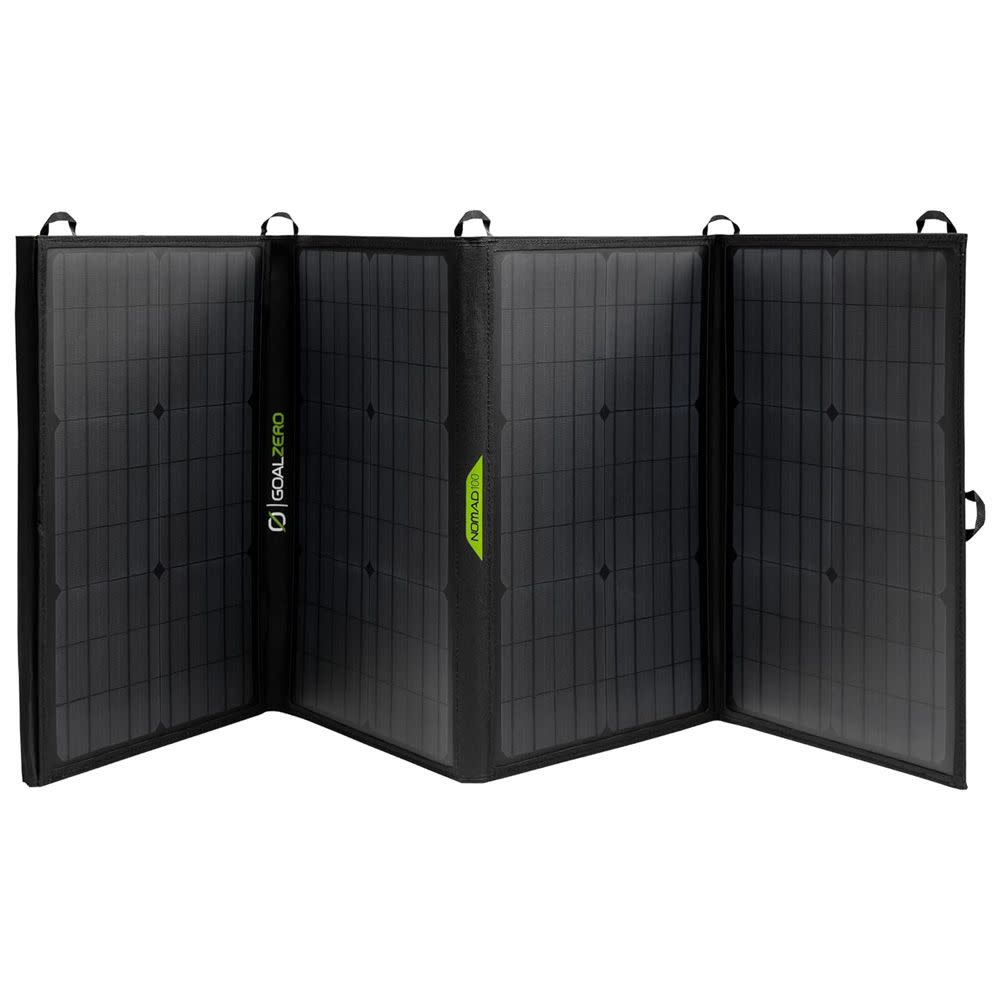
Nomad 100
amazon.com
$299.95
Explorer 2000 Plus Solar Generator Bundle
You see Jackery gear everywhere in the RV/van life scene these days because the brand offers such an expansive variety of dependable solar products. After using many Jackery generators, I found the 2000 Plus brings the perfect balance between physical size and capacity: Its 2000-watt-hour capacity is plenty for most campers, but it isn’t so large that you can’t bring it out when you need it.
Weighing a hefty 96 pounds, it isn’t exactly light, but compensates for the heft with integrated wheels and a telescoping handle so you only need to lift it to get it on and off your vehicle. Plus, it has a 25A plug, so it's designed specifically to bring on an RV.
This kit pairs the 2000 Plus with two of Jackery’s 200W SolarSaga panels, which are among the best you can find. They’re very durable—I can’t tell you how hard I’ve worked them over the years. Plus, they fold down to an easy-to-carry package, and are reliable in most sunlight conditions.
And, if you need even more juice at some point, you can expand the 2000 Plus’ capacity with up to five of the brand’s 2000 Plus battery packs, which can store as much as 12,000 watt-hours of power. That’s more than you’ll ever need on an RV, but it’s always nice to have the option.
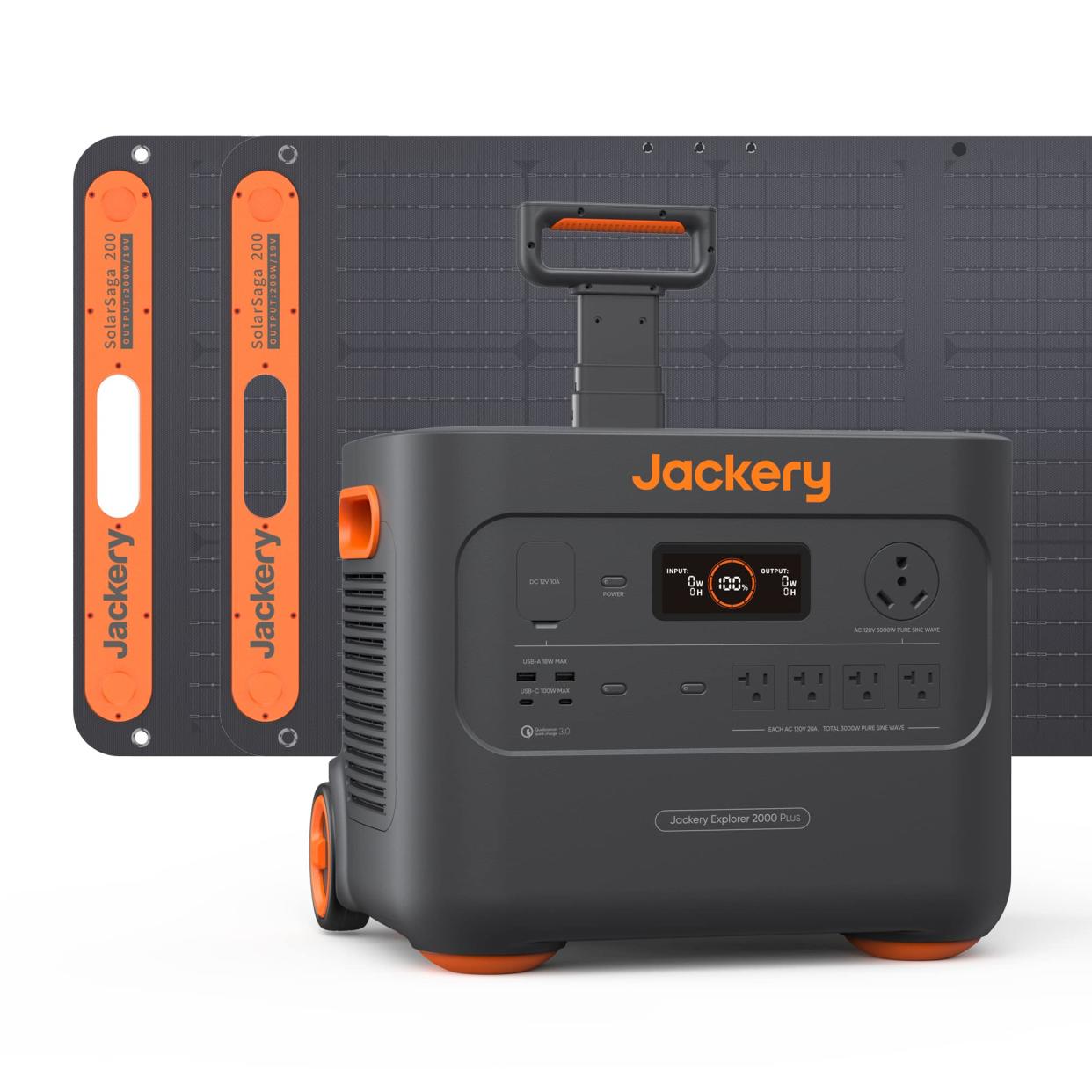
Explorer 2000 Plus Solar Generator Bundle
amazon.com
$3099.00
220W Bifacial Foldable Solar Panel
Bifacial panels, which can absorb solar energy using both their front and back face, aren’t as common among portable and RV panels as they are for home setups, but they definitely offer benefits while camping. By capturing solar energy from the light that bounces onto the back of the panel, they can capture more energy and be more efficient when it isn’t placed perfectly.
According to EcoFlow, the second face of their 220W Bifacial Foldable Solar Panel gathers 5- to 25-percent more energy than a single-sided panel. Personally. I’d say 25 percent is a stretch, but 15 seems in line with my experience and that’s not nothing: Every bit of juice counts when you’re on the road. I found it especially useful for off-season camping, when the days are shorter and you get a narrower window for gathering sunlight.
I also loved this panel’s tent-like stand design, which makes it easier to set up and place than other folding panels. It’s lightweight–just 20 pounds–but it’s also pretty big and can be tough to lug around.
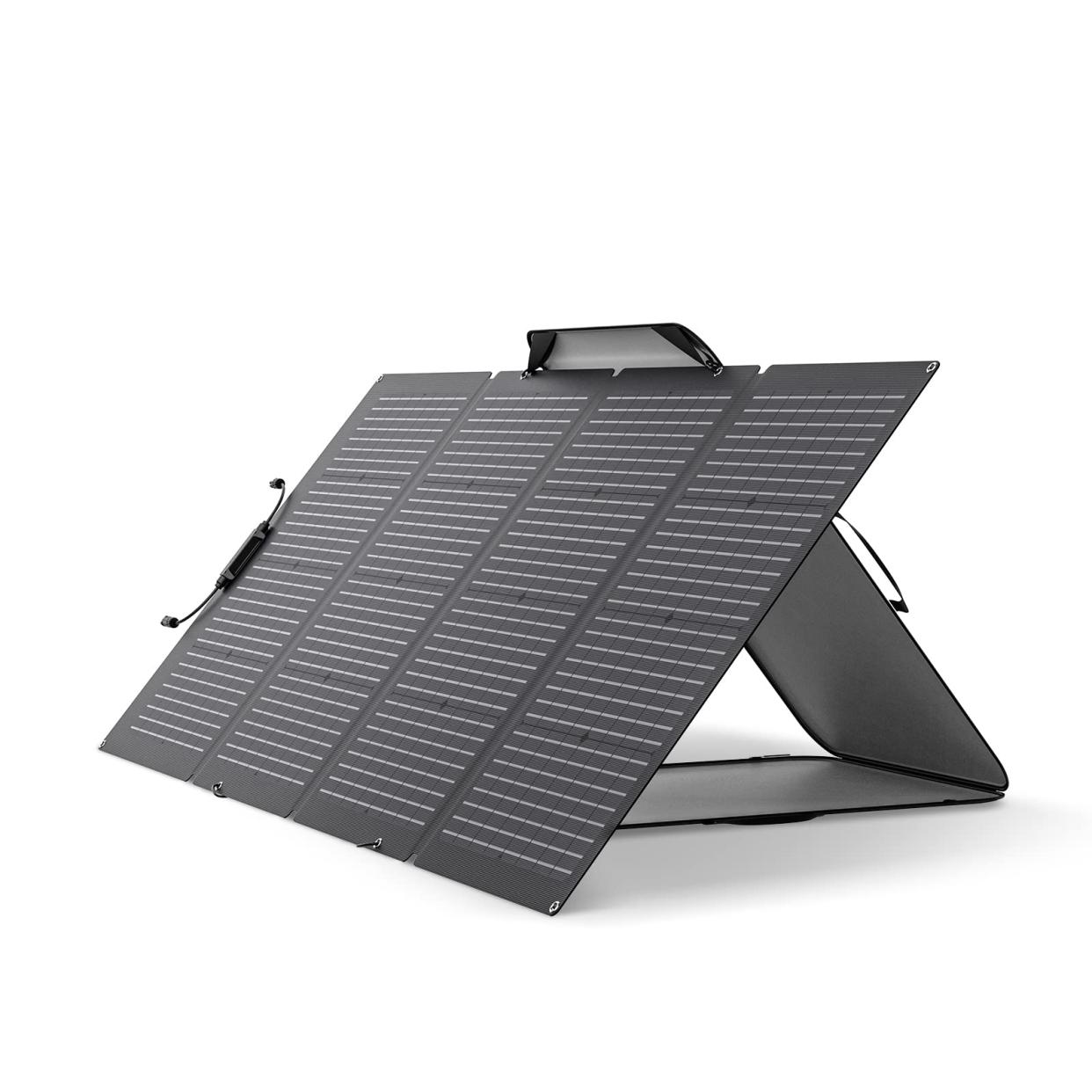
220W Bifacial Foldable Solar Panel
amazon.com
$549.00
Q+A With Our Experts
What kind of tools do I need to install a solar panel on my RV?
Much of the work can be done with basic tools you likely already have like a cordless drill, screwdrivers, and wrenches. I’d also recommend keeping a pair of wire cutters and strippers handy, as well as a hydraulic crimper, a MC4 connector/crimper tool, and a digital multimeter. As with any project involving electricity, it’s always a good idea to use dielectric tools that won’t conduct electricity.
Will mounting a solar panel on my RV change how I drive?
It’s unlikely. Typically your panels are more or less flush against the roof, which shouldn’t noticeably alter the aerodynamics of your RV.
Any advice on how to park my RV for great solar panel placement?
Try to park with the front to the east and the rear to the west. This will provide your roof with the maximum amount of sun throughout the day. As an added bonus, if you’ve got a typical left-sided fridge it will keep it somewhat shaded, reducing its power demand. When parked in direct sun, keep your window blinds closed to keep the interior cooler, further reducing the strain on your fridge.
Can I use my solar panel to jump-start my RV?
The short answer is no. The long answer is that the energy collected from a solar panel needs to be converted to a voltage and amperage required by whatever you want to use or charge. Without a charge controller to regulate power flow, and monitor battery charge levels, the current your solar panel outputs won’t be compatible with your RV’s battery.

You Might Also Like
